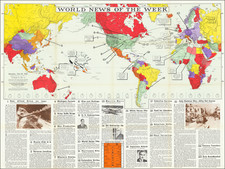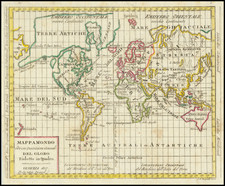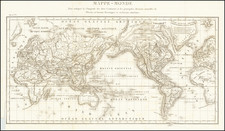Modern Fascimile of the Fra Mauro Map of the World.
Seven-foot by seven-foot facsmile of the circa 1450 Fra Mauro Mappamundi, the greatest medieval map of the world.
Created in a modern workshop in Verona, the present example is a remarkable full size facsimile of one of the great cartographic treasures of medieval times.
The Fra Mauro Map
The Fra Mauro map is "considered the greatest memorial of medieval cartography" (Almagià 1944). It took years to complete and was expensive to produce. The map contains hundreds of detailed illustrations and more than 3000 descriptive texts. It was the most detailed and accurate representation of the world that had been produced up until that time. As such, the Fra Mauro map is considered one of the most important works in the history of cartography. It marks the end of Bible-based geography in Europe and the beginning of embracing a more scientific way of making maps, placing accuracy ahead of religious or traditional beliefs. In a sense the Mauro map is the anti-Mercator projection map; Africa is at the top of the map, and Europe is at the bottom. In terms of square-footage, Africa and Asia dominate the image.
The map embodies the breadth of knowledge that was known to Medieval mapmakers and explorers. Interestingly, much of the novel information present on the map was lost to early modern cartographers when printed Ptolemy atlases proliferated in the last decades of the 15th century, replacing the manuscript Mappa Mundi tradition. The Fra Mauro map includes, among other items, the following important cartographic information:
- The Indian Ocean is shown "open", with a sea transit below southern Africa connecting it with the Atlantic. This was not rediscovered until Vasco da Gama's 1497-'99 sea voyage to India.
- The Indian Ocean likewise connects to the Pacific Ocean.
- Madagascar is possibly shown and labeled "DIAB". The first official record of a European seeing Madagascar was Diogo Dias in 1500.
- A large river is shown stretching far into the interior in southern Africa, possibly representing the Zambezi. The river is labeled: "flume xebe"
- The Tigris, Indus, Ganges, Yellow, and Yangtze Rivers are depicted.
- Japan is shown "Ixola de cimpagu". This is the first known Western depiction of Japan.
- The Korean Peninsula is illustrated.
Ironically, though Fra Mauro was superseded by Ptolemy at the end of the 15th century, he wrote on the map about the ways in which he was improving upon what Ptolemy had done more than 1000 years earlier:
I do not think it derogatory to Ptolemy if I do not follow his Cosmografia, because, to have observed his meridians or parallels or degrees, it would be necessary in respect to the setting out of the known parts of this circumference, to leave out many provinces not mentioned by Ptolemy. But principally in latitude, that is from south to north, he has much terra incognita, because in his time it was unknown.
The notes on the map provide a wealth of information about geographical knowledge in the 15th century. A typical note, in this case for England, is translated to English as:
Note that in ancient times Anglia [England] was inhabited by giants, but some Trojans who had survived the slaughter of Troy came to this island, fought its inhabitants and defeated them; after their prince, Brutus, it was named Britannia. But later the Saxons and the Germans conquered it, and after one of their queens, Angela, called it Anglia. And these peoples were converted to the Faith by means of St. Gregory the pope, who sent them a bishop called Augustine.
Today the Fra Mauro Map is held in the Museo Corer in Venice. An impressive manuscript facsimile was made in 1804 by British cartographer and antiquarian William Frazer. That map is now in the British Library.
We have also handled a small 18th century engraved facsimile of the Fra Mauro.












![[Second World War-era Japanese Pencil Sharpener Map of the World]](https://storage.googleapis.com/raremaps/img/small/84609.jpg)
![[The centre of this Slider is to be placed by a Thread or Pin over the centre of the respective Planisphere for any Operation]](https://storage.googleapis.com/raremaps/img/small/65557.jpg)


![[ World on Mercator's Projection ] Mappe-Monde suivant la projection de Mercator -- 1832](https://storage.googleapis.com/raremaps/img/small/99031.jpg)